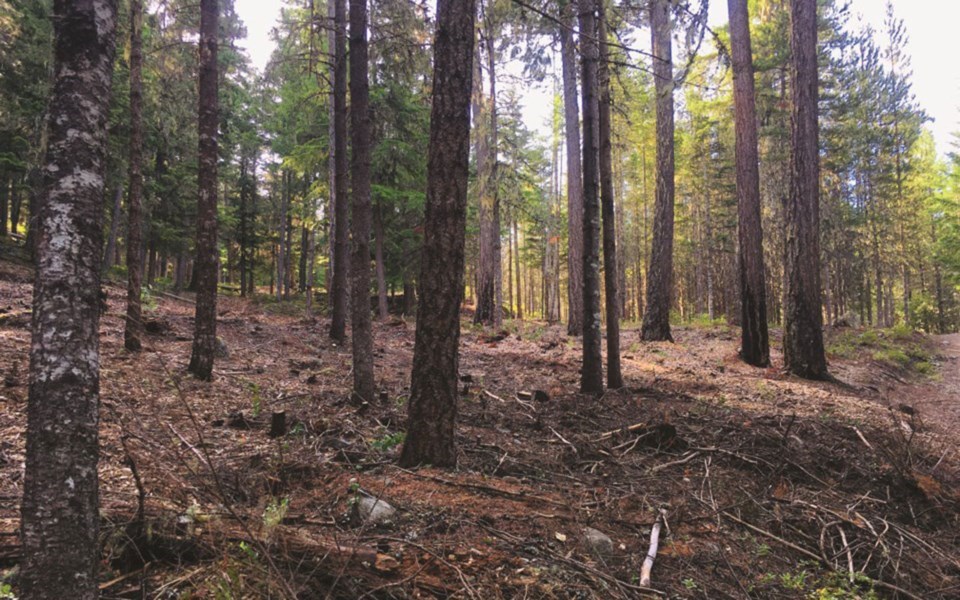The Resort Municipality of Whistler (RMOW) has welcomed a study by a local ecologist into fuel thinning as a positive addition to discussions around wildfire mitigation.
“We appreciate how lucky we are to have local research underway in the community—and the clear shared commitment to protect Whistler,” said the RMOW’s general manager of climate action, planning and development services, Dale Mikkelsen in an email to Pique.
“Our main goal is to keep our community safe, and new findings and studies simply further this work.”
The study, by local ecologist Rhonda Millikin was a self-funded and peer-reviewed study into the effect of fuel thinning on different tree stands around Whistler. Millikin has sought to test a theory that the process actually increased wildfire risk by increasing the temperature of the forest floor and drying out undergrowth, with her study eventually supporting that hypothesis.
Mikkelsen said that the RMOW was taking a strategic approach to “big problems” such as wildfire, explaining that fuel thinning was one part of a much larger Community Wildfire Resiliency Plan (CWRP) that balanced professional expertise, research, and data with industry best practices and approved by the municipal council.
“Fuel thinning is one important part of our plan for wildfire mitigation, but it is just one component of a much larger picture. We have taken a holistic approach, looking at seven areas of focus, including education, community planning, development considerations, interagency cooperation, FireSmart training and cross-training, emergency planning, and vegetation management.”
As part of Millikin’s study, she had questioned the effectiveness of fuel thinning on coastal forests such as that around Whistler, arguing that while it may be appropriate for other parts of the province, coastal forests were naturally resilient to wildfire due to high humidity and moisture, so thinning the forest simply dried it out and compromised that resiliency. Fuel thinning, by nature, is intended to thin out a forest to ensure that fires cannot spread into the crown of the forest and travel further. The forests around Whistler were clear-cut in previous decades, and unmanaged since, leading to the application of fuel thinning as a process due to dense undergrowth.
Pique asked about the RMOW’s data on the practice, and the effectiveness of applying it around Whistler.
“Our fuel thinning efforts are continually monitored, and our monitoring program does indicate it is a valuable tool for reducing fire,” said Mikkelsen.
“With this said, we do believe more work is needed to adequately answer this question, so we’re recommending an expansion of the program to really test the initial findings and understand regional changes. We have partnered with UBC and applied to Natural Resources Canada for the funds to do so.”
This year, the RMOW has focused on fuel thinning on four main areas around the community: Emerald West, Brio, Brio extension and along Hwy. 99.
Mikkelsen said that the Brio area fuel thinning was complete, while Emerald West and Brio extension were partially complete and delayed due to the high fire danger rating that applied to the region for much of summer.
“They will restart when conditions allow. Additionally, the work on Highway 99 is delayed as we wait for a Preliminary Field Assessment from the Lil'wat First Nation.”
Planning for the 2025 fire mitigation works is underway.
Pique posed some questions to the RMOW about some of the solutions offered as an alternative to fuel thinning by Millikin, who suggested setting up sprinklers on the edges of Whistler’s built-up areas to help with moisture.
Fire chief Thomas Doherty said that sprinkler protection was a tool applied by fire services, but “must be managed carefully as it is important we ensure our valuable water supply is available to the areas needing it the most in any wildfire event,” he said.
“Whistler shares a Structure Protection Unit with Squamish that would be used to set up sprinklers to protect homes in the path of wildfire. We also may have access to the Provincial Structure Protection Sprinkler System Resources, if it is available, through BC Wildfire.”
The best way to ensure the effectiveness of sprinklers is FireSmart, however.
“A focus on FireSmart principles and guidelines for properties is key to sprinkler work. A sprinkler system set up on a property which has not taken FireSmart measures will have little effect compared to a property where it’s employed. This includes things like pruning tree branches within two metres of the ground, regularly removing debris from your gutters, and removing debris (dry leaves, twigs and branches) from around your home.”
The complete RMOW FireSmart program and resources is available on their website.




